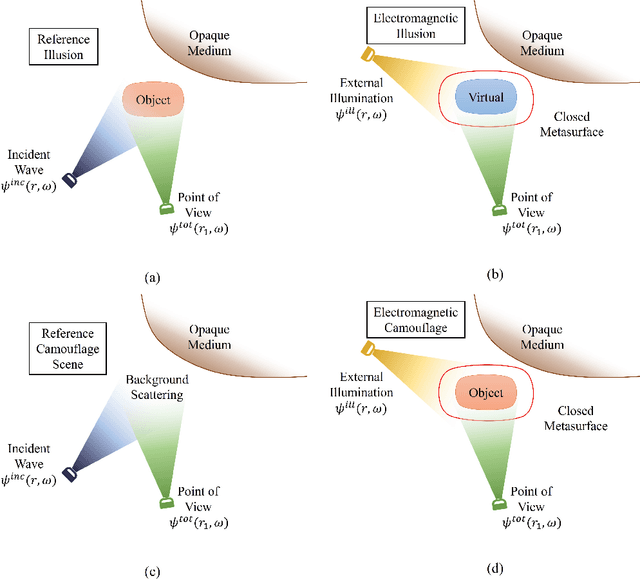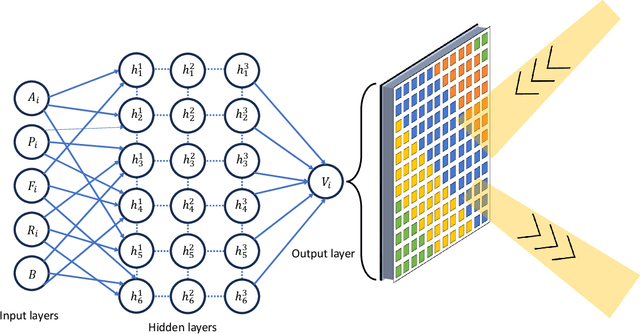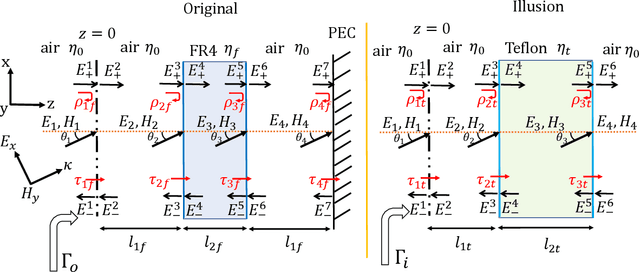Mohsen Khalily
Joint Beamforming and Position Optimization for Fluid STAR-RIS-NOMA Assisted Wireless Communication Systems
Jul 09, 2025Abstract:To address the limitations of traditional reconfigurable intelligent surfaces (RIS) in spatial control capability, this paper introduces the concept of the fluid antenna system (FAS) and proposes a fluid simultaneously transmitting and reflecting RIS (FSTAR-RIS) assisted non-orthogonal multiple access (NOMA) multi-user communication system. In this system, each FSTAR-RIS element is capable of flexible mobility and can dynamically adjust its position in response to environmental variations, thereby enabling simultaneous service to users in both the transmission and reflection zones. This significantly enhances the system's spatial degrees of freedom (DoF) and service adaptability. To maximize the system's weighted sum-rate, we formulate a non-convex optimization problem that jointly optimizes the base station beamforming, the transmission/reflection coefficients of the FSTAR-RIS, and the element positions. An alternating optimization (AO) algorithm is developed, incorporating successive convex approximation (SCA), semi-definite relaxation (SDR), and majorization-minimization (MM) techniques. In particular, to address the complex channel coupling introduced by the coexistence of direct and FSTAR-RIS paths, the MM framework is employed in the element position optimization subproblem, enabling an efficient iterative solution strategy. Simulation results validate that the proposed system achieves up to a 27% increase in total sum rate compared to traditional STAR-RIS systems and requires approximately 50% fewer RIS elements to attain the same performance, highlighting its effectiveness for cost-efficient large-scale deployment.
Terahertz Chip-Scale Meta-Networks with LSPR Routing: A Theoretical Framework
Jul 03, 2025Abstract:Efficient chip-scale interconnects are essential for modern microelectronic-photonic systems, supporting high bandwidth and low-latency processing. Traditional wired links face high resistivity and latency, while millimeter-wave wireless solutions suffer from bandwidth congestion and interference. Terahertz (THz) plasmonic communication, based on surface plasmon polaritons (SPPs), offers high data rates and broad bandwidth, and is compatible with nanophotonic platforms. This work introduces a Binary Field-Driven Meta-Routing Method supported by a semi-analytical framework that models the tunable interaction between THz plasmonic phenomena and graphene's electromagnetic properties. By modulating graphene's impedance, the method enables dynamic coupling and routing of localized surface plasmon resonances (LSPRs) across a meta-network, facilitating real-time beam steering in chip-scale systems. Combining analytical conductivity models, coupled-mode theory, and algorithmic control, the approach enables predictive configuration of LSPR-based steering in reconfigurable graphene metasurfaces. Four meta-pixel antenna configurations Y-MetaRouter, MetaSwitcher, Penta-MetaEmitter, and CP-MetaCore are designed to support unidirectional radiation, bi-directional steering, frequency-driven transitions, and circular polarization, respectively. Chemical potential modulation creates reconfigurable LSPR pathways and virtual SPP channels. A Coupled-Mode Theory for Field-Driven LSPR Meta-Networks is proposed to model current distributions and predict far-field characteristics. Results show strong agreement between theory and full-wave simulations. A point-to-point meta-wireless link is analyzed, demonstrating scalability for low-latency, high-performance THz communication in WiNoC and chiplet applications. System-level metrics confirm feasibility for space-constrained, high-speed interconnects.
A Corrugated All-Metal Vivaldi Antenna for 5G Phased Array Applications
Feb 05, 2025Abstract:In this paper, a corrugated Vivaldi phased array antenna in the 28 GHz frequency band is proposed for 5G communication applications. The presented configuration features an all-metal antipodal antenna structure with a broad bandwidth ranging from 26 to 30 GHz and beam steering capabilities from -30 to +30 degrees. The proposed antenna consists of a 4x4 array configuration, where each element has dimensions of 6.46x6.46x14.25 mm, resulting in an overall antenna structure with dimensions of 25.84x25.84x14.25 mm. The corrugation method is applied to minimize surface currents, resulting in a reduction in interelement mutual couplings. Therefore, the return loss in the array structure for central elements is decreased, and the antenna gain and radiation efficiency are improved. Moreover, the improved radiation efficiency allows for higher power transmission and reception from an antenna, resulting in potentially higher data rates and better performance.
Holographic Metasurfaces Enabling Wave Computing for 6G: Status Overview, Challenges, and Future Research Trends
Jan 09, 2025



Abstract:Recent advancements in wave computing using metasurfaces are poised to transform wireless communications by enabling high-speed, energy-efficient, and highly parallelized signal processing. These capabilities are essential to meet the ultra-high data rates of up to 1 terabit per second and minimal latency as low as 1 millisecond required by next-generation wireless networks. Diverging from traditional digital processing, wave computing adopts continuous analog signals to foster innovative functions such as over-the-air computation, integrated sensing and communications, computational electromagnetic imaging, and physical-layer security. This article explores the potential of reconfigurable multi-functional metasurfaces in wave computing, emphasizing their pivotal role in facilitating seamless communications and addressing the escalating computational demands for sixth generation (6G) networks. As artificial intelligence has become one of the most prominent and rapidly advancing fields of research over the last decade, we also introduce a wave-domain-based machine learning approach aimed at achieving power-efficient, fast training and computation. Future research directions are discussed, underscoring how metasurface-based systems can merge computation with communication to innovate components of 6G networks, thus creating smarter, faster, and more adaptable wireless infrastructures.
An Overview of Electromagnetic Illusions: Empowering Smart Environments with Reconfigurable Metasurfaces
Apr 18, 2024



Abstract:This study delves into the innovative landscape of metasurfaces, with a particular focus on their role in achieving EM illusion (EMI) a facet of paramount significance. The control of EM waves assumes a pivotal role in mitigating issues such as signal degradation, interference, and reduced communication range. Furthermore, the engineering of waves serves as a foundational element in achieving invisibility or minimized detectability. This survey unravels the theoretical underpinnings and practical designs of EMI coatings, which have been harnessed to develop functional metasurfaces. EMI, practically achieved through engineered coatings, confers a strategic advantage by either reducing the radar cross-section of objects or creating misleading footprints. In addition to illustrating the outstanding achievements in reconfigurable cloaking, this study culminates in the proposal of a novel approach, suggesting the emergence of EMI without the need for physically coating the device to conceal and thus proposing the concept of a smart EMI environment. This groundbreaking work opens a new way for engineers and researchers to unlock exotic and versatile designs that build on reconfigurable intelligent surfaces (RIS). Crucially the designs enabled by the proposed approach, present a wide array of applications, encompassing camouflaging, deceptive sensing, radar cognition control, and defence security, among others. In essence, this research stands as a beacon guiding the exploration of uncharted territories in wave control through smart EMI environments, with profound implications spanning basic academic research in RIS through advanced security technologies and communication systems.
A Novel Transmission Policy for Intelligent Reflecting Surface Assisted Wireless Powered Sensor Networks
Apr 28, 2021



Abstract:This paper proposes a novel transmission policy for an intelligent reflecting surface (IRS) assisted wireless powered sensor network (WPSN). An IRS is deployed to enhance the performance of wireless energy transfer (WET) and wireless information transfer (WIT) by intelligently adjusting phase shifts of each reflecting elements. To achieve its self-sustainability, the IRS needs to collect energy from energy station to support its control circuit operation. Our proposed policy for the considered WPSN is called IRS assisted harvest-then-transmit time switching, which is able to schedule the transmission time slots by switching between energy collection and energy reflection modes. We study the achievable sum throughput of the proposed transmission policy and investigate a joint design of the transmission time slots, the power allocation, as well as the discrete phase shifts of the WET and WIT. This formulates the problem as a mixed-integer non-linear program, which is NP-hard and non-convex. We first relax it to one with continuous phase shifts, and then propose a two-step approach and decompose the original problem into two sub-problems. We solve the first sub-problem with respect to the phase shifts of the WIT in terms of closed-form expression. For the second sub-problem, we consider a special case without the circuit power of each sensor node, the Lagrange dual method and the KKT conditions are applied to derive the optimal closed-form transmission time slots, power allocation, and phase shift of the WET. Then we generalise the case with the circuit power of each sensor node, which can be solved via employing a semi-definite programming relaxation. The optimal discrete phase shifts can be obtained by quantizing the continuous values. Numerical results demonstrate the effectiveness of the proposed policy and validate the beneficial role of the IRS in comparison to the benchmark schemes.
 Add to Chrome
Add to Chrome Add to Firefox
Add to Firefox Add to Edge
Add to Edge